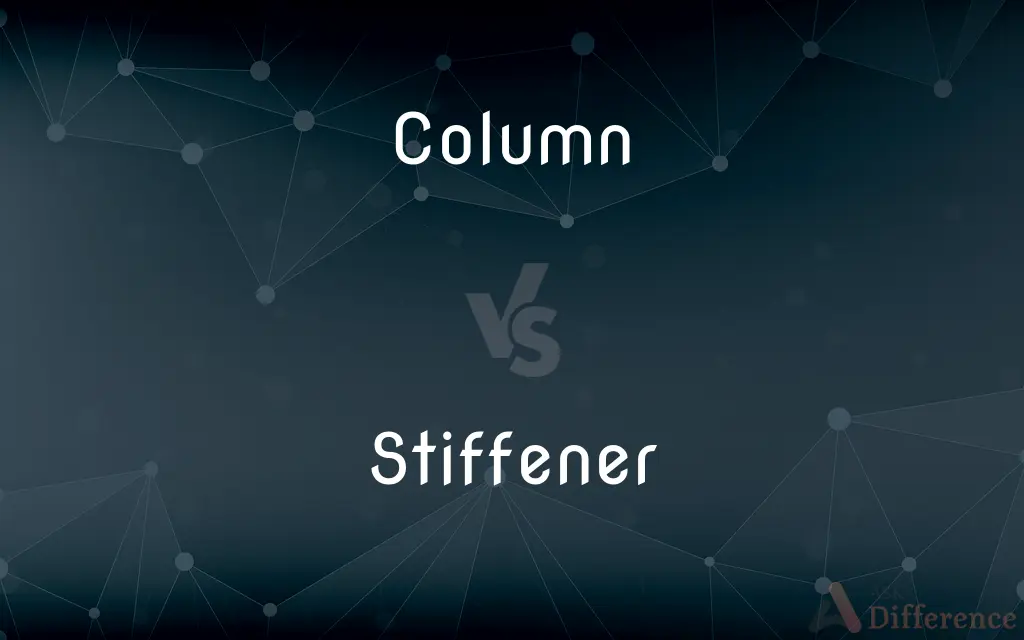Column vs. Stiffener — What's the Difference?
By Urooj Arif & Fiza Rafique — Updated on March 22, 2024
A column is a structural element bearing loads, while a stiffener reinforces parts against stress.

Difference Between Column and Stiffener
Table of Contents
ADVERTISEMENT
Key Differences
Columns are pivotal in the structural integrity of buildings and bridges, bearing vertical loads and transferring them to the foundation. In contrast, stiffeners are used to strengthen and stabilize specific parts of a structure, like beams or plates, to prevent buckling or deformation under stress. While columns are primary load-bearing elements, stiffeners play a supporting role, enhancing the strength of other structural components.
The design of a column often focuses on its ability to withstand axial loads, making it crucial in the overall stability of a structure. Stiffeners, however, are designed based on the needs of the component they are reinforcing, which can vary greatly depending on the structure's design and the type of stress encountered. This difference underscores the distinct roles each plays in structural engineering, with columns being central to load distribution and stiffeners providing localized support.
Columns are typically more prominent and integral to the architectural design, contributing to both the aesthetics and the functionality of a building or structure. Stiffeners, on the other hand, are usually less visible and more functional in nature, often hidden within the structure or along the elements they are reinforcing. This distinction highlights the balance between form and function in architectural and engineering design, with columns often serving as both structural necessities and design features, whereas stiffeners are primarily focused on enhancing structural integrity.
In terms of materials, both columns and stiffeners can be made from a variety of substances, including steel, concrete, and wood, depending on the requirements of the structure. However, the choice of material and the design of each are heavily influenced by their specific roles and the types of loads they need to support. This highlights the tailored approach needed in structural engineering to ensure that each element, whether a primary column or a reinforcing stiffener, is optimally designed for its intended purpose.
The engineering behind columns and stiffeners involves a deep understanding of mechanics and material properties, ensuring that each component is capable of performing its function effectively. While columns must be designed to prevent buckling under compressive loads, stiffeners must be designed to reinforce and prevent failure in the elements they support, demonstrating the specialized knowledge required to engineer structures that are both safe and efficient.
ADVERTISEMENT
Comparison Chart
Primary Function
Bearing vertical loads
Reinforcing components against stress
Role in Structure
Primary load-bearing element
Secondary support element
Visibility
Often visible and part of design
Usually less visible, more functional
Design Focus
Axial load capacity
Localized reinforcement
Material Use
Steel, concrete, wood, etc.
Same as columns, tailored to need
Compare with Definitions
Column
A vertical structure element designed to transmit a compressive load.
The ancient Greek temple is known for its ornate columns.
Stiffener
Provides additional support to areas susceptible to buckling or deformation.
The thin metal plates were equipped with stiffeners to withstand the wind pressure.
Column
Integral in maintaining the stability and integrity of buildings.
During the renovation, they added two steel columns for extra support.
Stiffener
A structural element used to reinforce parts of a structure to prevent failure.
Stiffeners were added to the bridge's beams to enhance their load-bearing capacity.
Column
Often contributes to the aesthetic appeal of architectural designs.
The marble columns added an elegant touch to the grand entrance.
Stiffener
Can be used in a variety of structural components, from beams to plates.
To avoid the risk of buckling, stiffeners were strategically placed along the length of the beam.
Column
Designed to resist buckling and ensure load distribution.
The engineering team calculated the necessary dimensions for the building's columns to prevent buckling.
Stiffener
Enhances the overall stability and durability of structures.
The addition of stiffeners significantly increased the lifespan of the aging structure.
Column
Can be decorative or functional, supporting roofs, floors, or other structures.
The open-concept design featured slender, decorative columns along the perimeter.
Stiffener
Often tailored to the specific needs of the component being reinforced.
Custom stiffeners were fabricated to match the curvature of the arched roof.
Column
A column or pillar in architecture and structural engineering is a structural element that transmits, through compression, the weight of the structure above to other structural elements below. In other words, a column is a compression member.
Stiffener
To make or become stiff or stiffer.
Column
A vertical structure usually consisting of a base, a cylindrical shaft, and a capital, used as a support or standing alone as a monument.
Stiffener
Anything added to something in order to stiffen it, such as a support beam, or starch for a collar.
Column
Any slender vertical support, as of steel or reinforced concrete.
Stiffener
(slang) An alcoholic drink taken to fortify oneself.
Column
Something resembling an architectural column in form or function
A column of mercury in a thermometer.
Stiffener
One who, or that which, stiffens anything, as a piece of stiff cloth in a cravat.
Column
One of two or more vertical sections of text lying side by side in a document and separated by a rule or a blank space.
Stiffener
Material used for stiffening something
Column
An arrangement of numbers in a single vertical line.
Column
A feature article that appears regularly in a publication, such as a newspaper.
Column
A formation, as of troops or vehicles, in which all elements follow one behind the other.
Column
(Botany)A columnlike structure, especially one formed by the union of a stamen and the style in an orchid flower, or one formed by the united staminal filaments in flowers such as those of the hibiscus or mallow.
Column
(Anatomy)Any of various tubular or pillarlike supporting structures in the body, each generally having a single tissue origin and function
The vertebral column.
Column
(architecture) A solid upright structure designed usually to support a larger structure above it, such as a roof or horizontal beam, but sometimes for decoration.
Column
A vertical line of entries in a table, usually read from top to bottom.
Column
A body of troops or army vehicles, usually strung out along a road.
Column
A body of text meant to be read line by line, especially in printed material that has multiple adjacent such on a single page.
It was too hard to read the text across the whole page, so I split it into two columns.
Column
A unit of width, especially of advertisements, in a periodical, equivalent to the width of a usual column of text.
Each column inch costs $300 a week; this ad is four columns by three inches, so will run $3600 a week.
Column
(by extension) A recurring feature in a periodical, especially an opinion piece, especially by a single author or small rotating group of authors, or on a single theme.
His initial foray into print media was as the author of a weekly column in his elementary-school newspaper.
Column
Something having similar vertical form or structure to the things mentioned above, such as a spinal column.
Column
(botany) The gynostemium
Column
(chemistry) An object used to separate the different components of a liquid or to purify chemical compounds.
Column
A kind of pillar; a cylindrical or polygonal support for a roof, ceiling, statue, etc., somewhat ornamented, and usually composed of base, shaft, and capital. See Order.
Column
Anything resembling, in form or position, a column in architecture; an upright body or mass; a shaft or obelisk; as, a column of air, of water, of mercury, etc.; the Column Vendôme; the spinal column.
Column
A body of troops formed in ranks, one behind the other; - contradistinguished from line. Compare Ploy, and Deploy.
Column
A number of ships so arranged as to follow one another in single or double file or in squadrons; - in distinction from "line", where they are side by side.
Column
A perpendicular set of lines, not extending across the page, and separated from other matter by a rule or blank space; as, a column in a newspaper.
Column
A perpendicular line of figures.
Column
The body formed by the union of the stamens in the Mallow family, or of the stamens and pistil in the orchids.
Column
One of a series of articles written in a periodical, usually under the same title and at regular intervals; it may be written and signed by one or more authors, or may appear pseudonymously or anonymously, as an editorial column.
Column
A line of (usually military) units following one after another
Column
A vertical glass tube used in column chromatography; a mixture is poured in the top and washed through a stationary substance where components of the mixture are adsorbed selectively to form colored bands
Column
A linear array of numbers one above another
Column
Anything tall and thin approximating the shape of a column or tower;
The test tube held a column of white powder
A tower of dust rose above the horizon
A thin pillar of smoke betrayed their campsite
Column
An article giving opinions or perspectives
Column
A vertical structure standing alone and not supporting anything (as a monument or a column of air)
Column
(architeture) a tall cylindrical vertical upright and used to support a structure
Common Curiosities
How do stiffeners contribute to a structure's integrity?
Stiffeners reinforce specific structural components, like beams or plates, to prevent buckling or deformation under stress, enhancing stability.
Can a structure have both columns and stiffeners?
Yes, many structures utilize both columns for primary support and stiffeners for additional reinforcement in specific areas.
Are columns always visible in a building's design?
Columns are often visible and can be integral to a building's aesthetic, though they can also be hidden within walls.
Where are stiffeners most commonly used?
Stiffeners are commonly used in beams, plates, and areas prone to buckling or deformation under load.
What types of structures benefit from stiffeners?
Structures that have components susceptible to high stress, such as long beams or slender plates, benefit from stiffeners.
Can the design of a column contribute to a building's aesthetic?
Yes, columns can be designed with decorative elements, contributing to the architectural appeal of a building.
How are columns designed to prevent failure?
Columns are designed to resist buckling and ensure load distribution by considering factors like height, material strength, and cross-sectional area.
Can the absence of sufficient stiffeners lead to structural failure?
Yes, without sufficient stiffening, parts of a structure may deform or buckle under stress, potentially leading to failure.
What is the main purpose of a column in construction?
The main purpose of a column is to bear vertical loads and transfer them to the foundation, ensuring structural stability.
Do columns and stiffeners use the same materials?
Both can be made from materials like steel, concrete, and wood, but the choice depends on their specific role and the loads they support.
How do engineers decide where to place stiffeners?
Engineers place stiffeners based on stress analysis, identifying areas that require additional support to prevent buckling or failure.
How does the addition of stiffeners impact the cost of a project?
Adding stiffeners increases material and labor costs, but it's often necessary for structural integrity and can prevent costly failures.
Are stiffeners always made of metal?
No, stiffeners can be made of various materials, but metal is common due to its strength and durability.
Do all columns bear the same type of load?
While all columns are designed to bear vertical loads, the specific loads vary depending on the structure's design and the column's location.
What is the difference between a beam and a stiffener?
A beam is a primary load-bearing element, often horizontal, while a stiffener is a secondary element that reinforces parts of a structure like beams.
Share Your Discovery

Previous Comparison
Altimeter vs. Barometer
Next Comparison
Chasse vs. SashayAuthor Spotlight
Written by
Urooj ArifUrooj is a skilled content writer at Ask Difference, known for her exceptional ability to simplify complex topics into engaging and informative content. With a passion for research and a flair for clear, concise writing, she consistently delivers articles that resonate with our diverse audience.
Co-written by
Fiza RafiqueFiza Rafique is a skilled content writer at AskDifference.com, where she meticulously refines and enhances written pieces. Drawing from her vast editorial expertise, Fiza ensures clarity, accuracy, and precision in every article. Passionate about language, she continually seeks to elevate the quality of content for readers worldwide.
















































